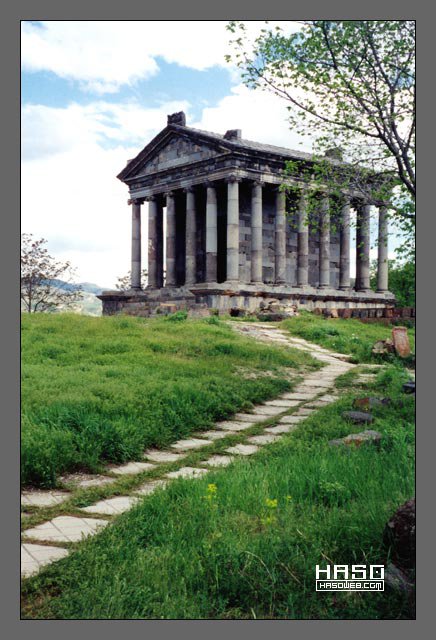 |
| Holy Resrection Armenian Church of Bangladesh |
Dhaka, Bangladesh - There have never been very large enclaves of Armenians residing in Asia or the Far East however the presence of pockets of Armenians in the region and their impact on the societies in which they lived have left their mark despite the dwindling of these communities over time.
The footprints of Armenians in Asia can be traced back to the seventeenth century and there is no greater symbol of the Armenian presence than the Armenian Apostolic Church spotted in various locations in the region, still standing with their courtyards of tombstones filled with life stories of Armenian traders and merchants.
One such oasis can be found in the capital city of Bangladesh in Dhaka, the Armenian Apostolic Church of Holy Resurrection.
The Armenian population of Dhaka began taking root in the early part of the 18th century most of whom were engaged in the jute trade with some prominent Armenian merchants who owned their own companies. The earliest settlers built a small chapel in the midst of their community graveyard but by the end of the century the Armenian community had grown considerably and the chapel became inadequate for the needs of the community. In 1781 the Church of Holy Resurrection was completed as a place of worship and gathering. In 1837, the belfry that also served as a clock tower was added and in 1907 a parsonage was built.
Today, the Church grounds continues to stand in Armanitola, Old Dhaka as a major landmark with the original edifice and buildings well-restored and over two hundred gravestones nestled on the estate. Still an oasis of peace and tranquillity in the surrounding chaos of the district, the immediate area is highly dense with populace and industry primarily in chemical and paper trading. Whilst the resounding Armenian language may no longer be resonating from the altar and filling the once thriving church, the Armenian spirit continues to linger with the inscriptions, motifs, designs, crosses and monuments that decorate the fasciae and facades. And so in December 2013, with the blessing of His Holiness Karekin II, Supreme Patriarch and Catholicos of All Armenians, an international delegation from the Armenian Apostolic Church headed by His Grace Bishop Haigazoun Najarian, Primate of the Diocese of Australia and New Zealand, accompanied by Mr. Haig Didizian (London), Mr. and Mrs. Armen and Laura Arslanian (Los Angeles), Mr. Hagop Didizian (London), and Mr. Pierre Hennes and Ms. Cheryl Ho (Singapore) departed on an exploratory visit to learn more about the overall current situation of the Church and the Armenian community, meeting with key stakeholders and community members, most notably long-standing Church Custodian, Mr Michael Joseph Martin.
Mr Martin (born Mikel Housep Martirossian in Yangon, Myanmar 1930) came to Dhaka in 1942 during World War II following in the footsteps of his father who had settled in the region decades earlier. Now widowed with three daughters who reside in Canada, Mr Martin took on the role of Custodian in 1986 and continues to oversee all its needs until today. He resides in the custodian's residence (formerly the parsonage) which is adjacent to the Church. The grounds also house a caretaker's residence and a building dated back to 1929 which was once used as a schoolhouse and residential quarters.
According to Mr Martin there are currently 50-60 families in Bangladesh who are of mixed Armenian-Bangla descent. "Sometimes there were several thousand Armenians trading in the Bengal region." He notes, "They were always an important community in Dhaka and dominated the country's trading. They were the who's who in town. They celebrated all their religious festivals with pomp and style." He also recalls how "every Sunday was a day of festival for us. Almost every Armenian would attend the service, no matter how big he was in social position. The Church was the centre of all activities."
The decline of the community however came gradually after the British left India and the subcontinent was partitioned in 1947 with Dhaka becoming the capital of East Pakistan and then of Bangladesh after it gained independence in 1971. Martin said the once-busy social scene came to a halt after the last Armenian priest Bagrat left in the mid 1960's.
These days, the Armenian Church holds only occasional services on major feasts in the Orthodox Christian calendar with a visiting priest leading the services.
During the delegation's three-day visit, His Grace Bishop Najarian celebrated the Divine Liturgy in the Church of Holy Resurrection on Friday 13 December during which he presented Mr Martin with the Encyclical conferred upon by His Holiness Karekin II Supreme Patriarch and Catholicos of All Armenians recognising his dedicated contribution and devotion to the Church. He was bestowed the St Nerses Shnorhali Medal a tribute reserved for noteworthy recipients who demonstrate exemplary and time-honoured service.
Mr Martin's determination to continue to maintain and preserve the jewel of the Armenian Church of Dhaka is best summed up by his own words (as recorded by the BBC) ...
"Whatever happens, I'm determined not to let this church go to the rack and ruin. I may be the last resident Armenian in Bangladesh, but I will do everything in my power to ensure an Armenian from abroad takes over the job." Despite a diminished community Martin stands firm in his resolve, "I've seen bad days before, but we always bounced back. I am sure Armenians will come back here for trade and business. I will then rest in peace beside my wife."
Dhaka has an estimated population of more than 23 million people, making it the largest city in Bangladesh and the 8th largest city in the world.
For more information about Armenian history and communities in Asia, please visit: www.armeniansinasia.org.

